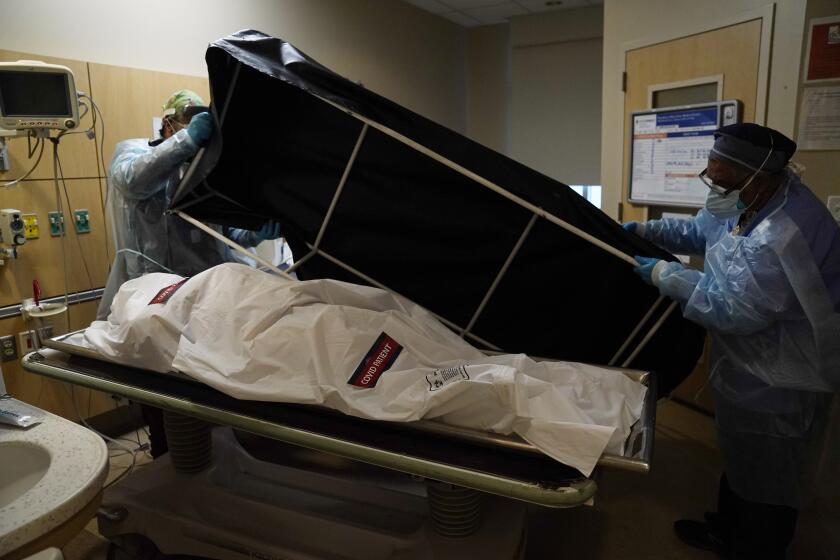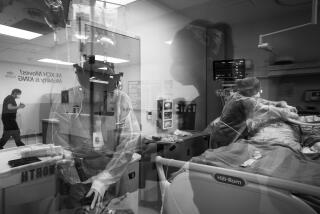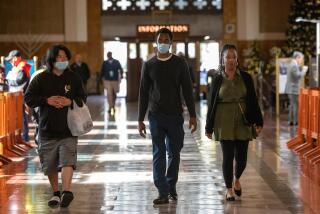How your DNA might make you more susceptible to COVID-19
- Share via
Scientists who sifted through the genetic data of nearly 50,000 COVID-19 patients have discovered 13 key locations among the human genome’s 3 billion base pairs that may influence a person’s susceptibility to a coronavirus infection or their risk of developing a severe illness.
The findings, published Thursday in the journal Nature, could help researchers design or repurpose treatments for COVID-19.
The research “shows clearly that it is possible to quickly do a human genomic study of infectious disease and find useful, medically relevant results,” said Samira Asgari, a statistical geneticist at Brigham and Women’s Hospital in Boston who was not involved in the work.
One of the coronavirus’ distinctive characteristics is its ability to trigger severe disease in some people and practically no symptoms at all in others. It’s become clear that many environmental and biological factors play a role — for example, a person’s age and socioeconomic status, their history of diabetes or heart disease, and whether they smoke.
“But even when those things are accounted for, a lot of times we still see differences in outcome,” Asgari said.
Our DNA may provide at least a partial explanation.
Scientists know that genetic variation can influence the severity of other infectious diseases. In some cases, rare mutations can mean the difference between mild symptoms and serious illness. Other, more common genetic variations can have a more moderate effect on disease severity.
For every confirmed coronavirus infection in the U.S. during the spring and summer of 2020, 4.8 other cases went undetected, a new study finds.
Human genomics studies of infectious diseases are fairly rare compared to those of other diseases with a complex genetic basis. That’s largely because scientists tend to study the microbe causing the disease rather than the host being infected, said Asgari, who co-wrote a commentary that Nature published with the findings.
On top of that, the effects of genetic variation are typically pretty small when weighed against factors such as age or access to healthcare. This means that researchers would have to put together studies with tens of thousands of participants — if not more — whose characteristics are well-known in order to detect a subtle genetic link. And they’d have to do it fast, in the short period when an infection is still triggering symptoms.
To overcome these challenges, scientists from around the world joined forces early in the pandemic to create the COVID-19 Host Genetics Initiative. Their collaboration grew to include more than 3,000 researchers and clinicians who combined data from 46 studies involving a total of 49,562 people from 19 countries who had COVID-19, and 2 million others without the disease who served as controls.
Along with subjects’ genetic information, they gathered key metrics, such as age and sex, that can play a role in disease severity.
Scientists are skeptical of the Institute for Health Metrics and Evaluation’s new way of counting COVID-19 cases and their claim that the pandemic’s toll is twice as bad as we thought.
Their analysis turned up four loci, or locations in the human genome, that are linked to a person’s risk of being infected with SARS-CoV-2, and nine other loci that are associated with disease severity.
The scientists then looked for genes that were close to each of these loci, turning up more than 40 candidates. Many had previously been linked to the workings of the lungs or the immune system.
Among them was the widely studied gene known as TYK2. People with a particular version of this gene are more susceptible to infection by pathogens other than SARS-CoV-2, but they’re also at lower risk of developing many kinds of autoimmune disease. In the new study, researchers found that certain mutations in TYK2 are associated with a 29% to 59% higher risk of severe COVID-19.
A number of the loci tied to the risk of severe COVID-19 appeared to be associated with genes involved in lung disease — no huge surprise, given that SARS-CoV-2 attacks the respiratory system.
One of the candidate genes near the loci associated with infection risk was SLC6A20, which interacts with the ACE2 receptor — the one the coronavirus targets to unlock and invade a cell. Another candidate gene is ABO, which helps determine a person’s blood type.
Two decades of progress in closing a yawning gap between the life expectancy of Black and white Americans has been erased by COVID-19.
Asgari pointed out that two of the loci were found only by including people with East Asian ancestry in the study — underscoring the importance of having a diverse group of people in this kind of research.
Such studies may help scientists better understand how to fight COVID-19, she said — though the information should be part of a larger strategy.
“Genetics is a component that can help us with finding new drug targets, with understanding the biology of infectious diseases,” Asgari said. “But you shouldn’t give up on all the other nongenetic factors that have really, really big effects.”
Of course, the coronavirus is not static — it’s spinning off new variants, such as the Delta variant now spreading across the globe. It’s unclear what happens when the genetic diversity of the virus meets the genetic diversity of humans. But scientists say they’d like to find out.
“I think many of us are very excited to be able to look at the potential interaction between the host genome and the viral genome,” said geneticist Mark Daly, director of the Institute for Molecular Medicine Finland and one of the study’s senior authors. Now that researchers have identified key factors in the human genome, he added, “we have an opportunity to take the next steps.”









